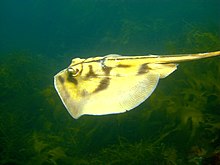
The deepwater stingray or giant stingaree is a species of stingray and the sole member of the family Plesiobatidae. It is widely distributed in the Indo-Pacific, typically over fine sediments on the upper continental slope at depths of 275–680 m (900–2,230 ft). This species reaches 2.7 m (8.9 ft) in length and 1.5 m (4.9 ft) in width. It has an oval pectoral fin disc with a long, flexible, broad-angled snout. Most of the entire latter half of its tail supports a distinctively long, slender, leaf-shaped caudal fin. Its coloration is dark above and white below, and its skin is almost completely covered by tiny dermal denticles.
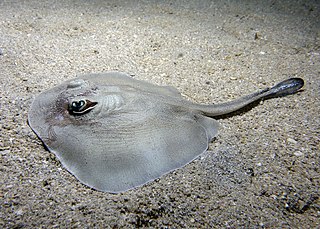
The western shovelnose stingaree is a common species of stingray in the family Urolophidae, inhabiting shallow sandy flats and seagrass beds off southwestern Australia from Perth to Gulf St Vincent. Growing to 37 cm (15 in) long, this small ray has a rounded pectoral fin disc and a blunt, broadly triangular snout. Its nostrils have enlarged lobes along the outer rims and a skirt-shaped curtain of skin between them with a strongly fringed posterior margin. Its tail ends in a lance-like caudal fin and lacks dorsal fins and lateral skin folds. This species is colored grayish to brownish above, sometimes with lighter and darker spots, and pale below, sometimes with darker marginal bands and blotches.
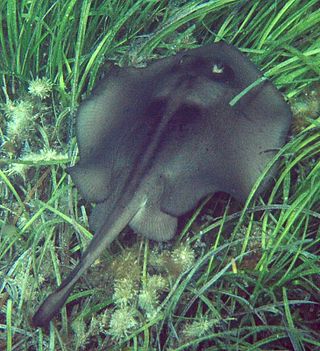
Trygonoptera is a genus of round rays endemic to the waters around Australia. Müller and Henle defined Trygonoptera in 1841. It has often been considered synonymous with Urolophus, but this has been refuted by recent studies. Trygonoptera can be distinguished from Urolophus in that the outer rims of its nostrils are enlarged into broad, flattened lobes; the two also differ in aspects of the skeleton.

The striped stingaree is a common but little-known species of stingray in the family Urolophidae, endemic to shallow, inshore waters off southwestern Australia. Reaching 61 cm (24 in) long, this species is characterized by an oval, grayish to brownish disc with darker mask-like markings around the eyes and paired blotches at the center of the disc that are extended posteriorly into horizontal lines. Its nostrils have enlarged lobes on the outer margins and a skirt-shaped curtain of skin with a deeply fringed trailing margin in between. Its tail terminates in a relatively large leaf-shaped caudal fin, and bears a small dorsal fin just before the stinging spine. The rounded, flexible disc of the striped stingaree enable it to maneuver through the rocks, reefs, and seagrass that comprise its favored habitats. The International Union for Conservation of Nature (IUCN) has listed this species under Least Concern; it is seldom caught by fisheries due to its habitat preferences.
The masked stingaree is a common species of stingray in the family Urolophidae, endemic to southwestern Australia. It prefers moderately deep areas of sand or seagrass some distance from shore, though it can be found in very shallow water or to a depth of 115 m (377 ft). The masked stingaree can be identified by the two large, dark blotches on the upper surface of its rounded pectoral fin disc, one of which encompasses its eyes like a mask. The outer rims of its nostrils are expanded into prominent lobes, while between the nostrils is a skirt-like curtain of skin with a deeply fringed trailing margin. Its tail bears a small dorsal fin just before the stinging spine, and end in a leaf-like caudal fin. This species grows up to 31 cm (12 in) across.
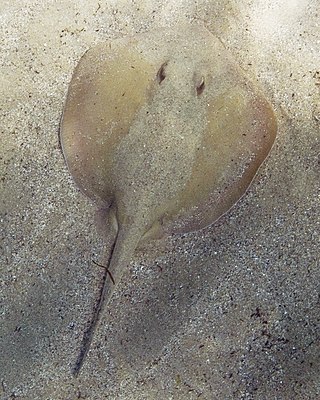
The common stingaree is a species of stingray in the family Urolophidae. The most abundant ray in inshore waters off eastern Australia, it generally inhabits estuaries, sandy flats, and rocky reefs from the shore to a depth of 60 m (200 ft). This plain brownish to grayish species has a rounded pectoral fin disc with a broadly triangular snout. Its nostrils have enlarged lobes on their outer margins and a skirt-shaped curtain of skin with a fringed posterior margin between them. Its tail bears a small dorsal fin before the stinging spine, and terminates in a leaf-shaped caudal fin. This ray can grow to 52 cm (20 in) long.
The New Ireland stingaree or black-spotted stingaree, is a species of stingray in the family Urolophidae, known only from a single juvenile male 17.4 cm (6.9 in) long, collected in the Bismarck Archipelago. This species has an oval pectoral fin disc with tiny eyes and a rectangular curtain of skin between the nostrils. Its tail is fairly long and terminates in a leaf-shaped caudal fin, and lacks a dorsal fin. Uniquely among stingarees, it has rows of sharp spinules on the posterior portion of its back and the base of its tail. Its dorsal coloration is brown with dark spots. The International Union for Conservation of Nature (IUCN) has listed this ray as Data Deficient, pending more information.

Urolophus is a genus of round rays mostly native to the western Pacific Ocean and the Indian Ocean, though one species occurs in the Pacific waters of the Mexican coast. Müller and Henle erected Urolophus in an 1837 issue of Bericht Akademie der Wissenschaften zu Berlin. The name is derived from the Greek oura, meaning "tail", and lophos, meaning "crest". In Urolophus, the outer rims of the nostrils are not enlarged into lobes, but may form a small knob at the back.

The sandyback stingaree or great stingaree is a little-known species of stingray in the family Urolophidae, endemic to southeastern Australia. It is generally found offshore around the edge of the continental shelf, at a depth of 65–265 m (213–869 ft). A relatively large species reaching 89 cm (35 in) long, the sandyback stingaree has a diamond-shaped pectoral fin disc wider than long, usually with a dorsal pattern of numerous fine lighter marks on a yellowish to brownish background. Its short tail terminates in a deep, leaf-shaped caudal fin, and bears a sizable dorsal fin just in front of the stinging spine.
The circular stingaree is an uncommon, little-known species of stingray in the family Urolophidae. Endemic to the coastal waters of southwestern Australia, it prefers a rocky and/or vegetated habitat. Reaching 60 cm (24 in) in length, this species is characterized by an oval pectoral fin disc bearing a striking dorsal pattern of lighter spots and rings, and a central circle of white-margined black spots, on a bluish gray background. Between its nostrils is a skirt-shaped curtain of skin, with the posterior corners drawn out into lobes. Its tail bears a rather large dorsal fin in front of the stinging spine, and ends in a deep, lance-like caudal fin. Negligibly affected by human activity, the circular stingaree has been listed under Least Concern by the International Union for Conservation of Nature (IUCN).

The crossback stingaree or banded stingaree is a species of stingray in the family Urolophidae. It is endemic to southeastern Australia, mainly off Victoria and Tasmania but also marginally to New South Wales and South Australia. This bottom-dwelling fish generally inhabits sand and reef habitats deeper than 100 m (330 ft) off Victoria, and muddy habitats in shallow bays and estuaries off Tasmania. Befitting its name, the crossback stingaree has a distinctive dark pattern on its back, consisting of a midline stripe that is crossed by three transverse bars. It has an oval pectoral fin disc with a blunt snout and a skirt-shaped curtain of skin between the nostrils. Its tail is short with no skin fold along the sides, and a deep, leaf-shaped caudal fin. The youngest rays may have a small dorsal fin in front of the stinging tail spine. This species reaches 50 cm (20 in) in length.
The patchwork stingaree is a little-known species of stingray in the family Urolophidae, with a disjunct distribution off northwestern and northeastern Australia. It usually inhabits the outer continental shelf, at a depth of 60–320 m (200–1,050 ft). This species has a diamond-shaped pectoral fin disc much wider than long, and a short, flattened tail with a prominent dorsal fin and leaf-like caudal fin. There is a skirt-shaped curtain of skin between its nostrils. Its dorsal color pattern resembles a mosaic of dark brown rings with light-colored centers, separated by fine reticulated lines. The International Union for Conservation of Nature (IUCN) has listed the patchwork stingaree under Least Concern, as it is subject to minimal fishing pressure.

The spotted stingaree is an uncommon species of stingray in the family Urolophidae, endemic to shallow waters along the coast of southern Australia. It favors rocky reefs and seagrass beds. This species can be readily identified by its nearly circular, dark-colored pectoral fin disc, adorned with a complex pattern of white or cream spots. Its eastern and western forms differ slightly in coloration and have been regarded as separate species. There is a skirt-shaped curtain of skin between its nostrils. Its tail is fairly thick and terminates in a short leaf-shaped caudal fin; a relatively large dorsal fin is present just in front of the stinging spine.
The Java stingaree was a species of stingray in the family Urolophidae, known only from a single female specimen 33 cm (13 in) long caught off Jakarta, Indonesia. This species is characterized by an oval-shaped pectoral fin disc longer than wide, and a tail with a dorsal fin in front of the stinging spine and a caudal fin. It is brown above, with darker and lighter spots. The International Union for Conservation of Nature has listed the Java stingaree as Extinct; it has not been recorded since its discovery over 150 years ago, and its range is subject to heavy fishing pressure and habitat degradation.
The lobed stingaree is a common species of stingray in the family Urolophidae, endemic to southern Western Australia in shallow, inshore sand and seagrass habitats. This species is plain sandy in color above and has a broad, rounded pectoral fin disc. It is characterized by an enlarged, semicircular skin lobe of unknown function on the inner rim of each nostril. Its tail is slender, with lateral skin folds and a lance-like caudal fin but no dorsal fin. The maximum recorded width is 27 cm (11 in).
The mitotic stingaree or blotched stingaree, is a little-known species of stingray in the family Urolophidae, so named because it has light blue blotches on its back that resemble cells undergoing mitotic division. Though not uncommon, it is found only in a small area of the outer continental shelf off northwestern Australia, at around 200 m (660 ft) down. This species attains a length of 29 cm (11 in) long and has a diamond-shaped pectoral fin disc with broadly rounded corners and a skirt-shaped curtain of skin between the nostrils. Its tail has subtle skin folds running along either side, no dorsal fin, and a slender leaf-shaped caudal fin. The International Union for Conservation of Nature (IUCN) has listed the mitotic stingaree under Least Concern, as there is little fishing within its range.
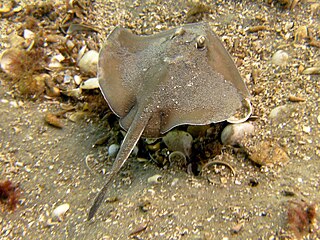
The sparsely spotted stingaree, also known as the white-spotted stingaree or Dixon's stingaree, is a species of stingray in the family Urolophidae, common off the southern Australian coast. Preferring sandy flats and seagrass beds, this benthic ray can be found from close to shore to a depth of at least 150 m (490 ft), and tends to occur deeper in the northern portion of its range. Reaching a length of 57 cm (22 in), this species has a broad, diamond-shaped pectoral fin disc that is typically plain gray in color above with a V-shaped marking between the eyes. Individuals from southerly waters also generally exhibit a smattering of small, dark-edged white spots. This ray is further characterized by a distinctively bell-shaped curtain of skin between the nostrils. Its tail has a skin fold running along either side and a leaf-shaped caudal fin, but no dorsal fin.

The Kapala stingaree is a species of stingray in the family Urolophidae, endemic to inshore waters off southeastern Queensland and New South Wales. It is commonly found on and around rocky reefs at a depth of 10–130 m (33–427 ft). Reaching 51 cm (20 in) in length, the Kapala stingaree has a rounded, diamond-shaped pectoral fin disc and a slender tail, which ends in a leaf-shaped caudal fin and bears lateral skin folds and a small dorsal fin in front of the stinging spine. It has a distinctive bell-shaped curtain of skin between its nostrils. This species is greenish above, with a highly variable pattern of dark markings usually found outside and between the eyes, and over the back and tail.
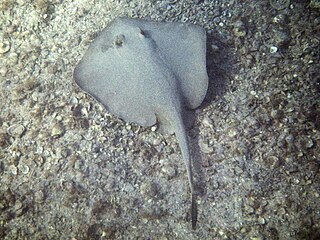
The greenback stingaree is a little-known species of stingray in the family Urolophidae, endemic to the outer continental shelf and upper continental slope off southeastern Australia. Growing to a length of 51 cm (20 in), this species has a diamond-shaped pectoral fin disc wider than long and uniformly light green in color above. Between its nostrils is a skirt-shaped curtain of skin. Its tail bears skin folds on either side and a deep, lanceolate caudal fin, but lacks a dorsal fin.
The brown stingaree is a little-known species of stingray in the family Urolophidae, found at a depth of 60–220 m (200–720 ft) on the outer continental shelf off northern Western Australia. This species has a rhomboid pectoral fin disc colored light yellow or brown, sometimes with three faint, darker, transverse bars. Its nostrils have a skirt-shaped curtain of skin between them. Its tail ends in a leaf-shaped caudal fin and either lacks or has poorly developed lateral skin folds and a dorsal fin. The maximum known length is 36 cm (14 in). The International Union for Conservation of Nature (IUCN) has listed the brown stingaree under Least Concern, as there is negligible fishing pressure across most of its range.
